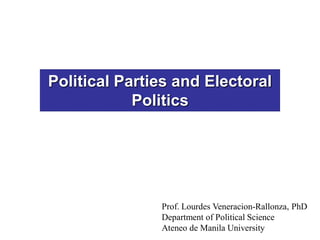
Political Parties And Electoral Politics
- 1. Political Parties and Electoral Politics Prof. Lourdes Veneracion-Rallonza, PhD Department of Political Science Ateneo de Manila University
- 2. POLITICAL PARTIES • group of people organized for the purpose of winning government power, by electoral or other means • interest holders united by a definite set of party programs and attempt to advance a consistent line of policy • main goal is to gain control of the levers of government so that they can realize their policies or programs
- 3. Characteristics • organizational structure w/ lines of authority and power distribution • seeks to attract popular support in the form of votes • recruits and fields candidates for elective positions
- 4. Types of Political Parties • Based on membership - mass - cadre - devotee • Based on arena of activities - constitutional - revolutionary
- 5. Types of Political Parties • Based on ideological orientation - Left parties (Far-left): goal is the eventual destruction of existing class hierarchies in society, by violence if necessary; call for comprehensive government intervention in the economy to redistribute wealth & guarantee welfare security to the most vulnerable - Center-Left parties: differ from left by their disavowal of violence and coercion; believe that equitable distribution of wealth is still a societal goal that should be realized by proper state intervention (with concurrence from the people)
- 6. Types of Political Parties • Based on ideological orientation - Center parties: believe in the value of self- initiative & a minimal state role on economy - Center-Right parties: believe that the task of the government is to provide peace and order and to ensure the proper enforcement of laws and legal contracts - Right parties (Far-Right): parties of ultra conservatism & exclusionism; believe in „natural‟ differences among humans and that there are some persons, races, religions, classes that are more fit to rule than others.
- 7. ELECTORAL POLITICS • vital connections between state authority and society, linking the structure of government to other social groupings • political action – seeking power to achieve policy objectives
- 8. ELECTIONS • “a device for filling an office through choices made by a designated body of people: the electorate” • for the ordinary citizen: “elections are seen as the clearest instance of politics entering their lives”
- 9. Functions • “Bottom-Up” functions (People Government View) – provide the citizenry with a meaningful way of participating in government – mechanism for leadership selection – An instrument for evaluating and changing governments – forum for interest articulation and political socialization
- 10. Functions • “Top-Down” functions (Government- People View) – instrument of rule legitimization – guide to political strategy – agent of political socialization and integration
- 11. Voting Activities in the Philippines • Elections – citizenry selects person who will exercise governmental power • Plebiscite - popular vote conducted to get electorate’s view on permanent changes to state’s political structure. • Referendum – popular vote regarding soundness of a law proposed • Recall – constitutional measure which empowers citizenry to remove a local official. • Initiative – a given percentage of voters may officially propose a law.
- 12. The Voting System in the Philippines: Party-List Party-List System – Art. VI Sec. 5 of the 1987 Philippine Constitution – - party-list representatives be elected to constitute 20 per centum of the total number of the seats in the House of the Representative Provides opportunity for under-represented sectors and parties in Philippine society to have a legitimate chance of winning representation in Congress
- 13. Quality of Elections in the Philippines • Anomalies in Philippine Elections: 1) lack of human manpower in the COMELEC 2) influence of “gold, guns and goons” 3) flying voters 4) vote buying 5) tampering with the election returns 6) „dagdag-bawas‟
- 14. Quality of Elections in the Philippines • Prevention of electoral frauds: 1) vigilance of the citizens 2) relevant government bodies 3) reforms such as computerization and continuous registration 4) political education 5) poll observers (local and international) during elections